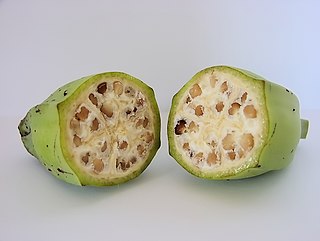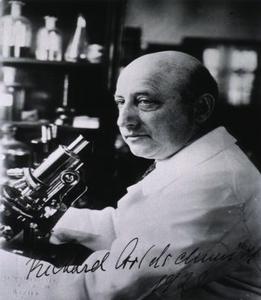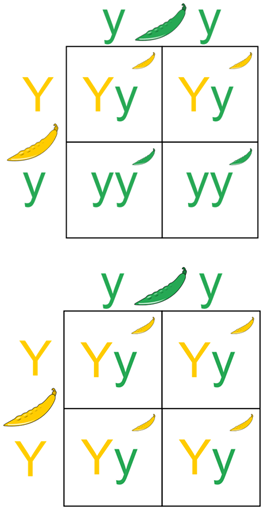
Drosophila is a genus of fly, belonging to the family Drosophilidae, whose members are often called "small fruit flies" or pomace flies, vinegar flies, or wine flies, a reference to the characteristic of many species to linger around overripe or rotting fruit. They should not be confused with the Tephritidae, a related family, which are also called fruit flies ; tephritids feed primarily on unripe or ripe fruit, with many species being regarded as destructive agricultural pests, especially the Mediterranean fruit fly.

In genetics, the phenotype is the set of observable characteristics or traits of an organism. The term covers the organism's morphology, its developmental processes, its biochemical and physiological properties, its behavior, and the products of behavior. An organism's phenotype results from two basic factors: the expression of an organism's genetic code and the influence of environmental factors. Both factors may interact, further affecting the phenotype. When two or more clearly different phenotypes exist in the same population of a species, the species is called polymorphic. A well-documented example of polymorphism is Labrador Retriever coloring; while the coat color depends on many genes, it is clearly seen in the environment as yellow, black, and brown. Richard Dawkins in 1978 and then again in his 1982 book The Extended Phenotype suggested that one can regard bird nests and other built structures such as caddisfly larva cases and beaver dams as "extended phenotypes".

The wild type (WT) is the phenotype of the typical form of a species as it occurs in nature. Originally, the wild type was conceptualized as a product of the standard "normal" allele at a locus, in contrast to that produced by a non-standard, "mutant" allele. "Mutant" alleles can vary to a great extent, and even become the wild type if a genetic shift occurs within the population. Continued advancements in genetic mapping technologies have created a better understanding of how mutations occur and interact with other genes to alter phenotype. It is now appreciated that most or all gene loci exist in a variety of allelic forms, which vary in frequency throughout the geographic range of a species, and that a uniform wild type does not exist. In general, however, the most prevalent allele – i.e., the one with the highest gene frequency – is the one deemed wild type.

Drosophila melanogaster is a species of fly in the family Drosophilidae. The species is often referred to as the fruit fly or lesser fruit fly, or less commonly the "vinegar fly", "pomace fly", or "banana fly". In the wild, D. melanogaster are attracted to rotting fruit and fermenting beverages, and are often found in orchards, kitchens and pubs.
A genetic screen or mutagenesis screen is an experimental technique used to identify and select individuals who possess a phenotype of interest in a mutagenized population. Hence a genetic screen is a type of phenotypic screen. Genetic screens can provide important information on gene function as well as the molecular events that underlie a biological process or pathway. While genome projects have identified an extensive inventory of genes in many different organisms, genetic screens can provide valuable insight as to how those genes function.
Forward genetics is a molecular genetics approach of determining the genetic basis responsible for a phenotype. Forward genetics provides an unbiased approach because it relies heavily on identifying the genes or genetic factors that cause a particular phenotype or trait of interest.

Non-Mendelian inheritance is any pattern in which traits do not segregate in accordance with Mendel's laws. These laws describe the inheritance of traits linked to single genes on chromosomes in the nucleus. In Mendelian inheritance, each parent contributes one of two possible alleles for a trait. If the genotypes of both parents in a genetic cross are known, Mendel's laws can be used to determine the distribution of phenotypes expected for the population of offspring. There are several situations in which the proportions of phenotypes observed in the progeny do not match the predicted values.

Richard Benedict Goldschmidt was a German geneticist. He is considered the first to attempt to integrate genetics, development, and evolution. He pioneered understanding of reaction norms, genetic assimilation, dynamical genetics, sex determination, and heterochrony. Controversially, Goldschmidt advanced a model of macroevolution through macromutations popularly known as the "Hopeful Monster" hypothesis.
Complementation refers to a genetic process when two strains of an organism with different homozygous recessive mutations that produce the same mutant phenotype have offspring that express the wild-type phenotype when mated or crossed. Complementation will ordinarily occur if the mutations are in different genes. Complementation may also occur if the two mutations are at different sites within the same gene, but this effect is usually weaker than that of intergenic complementation. When the mutations are in different genes, each strain's genome supplies the wild-type allele to "complement" the mutated allele of the other strain's genome. Since the mutations are recessive, the offspring will display the wild-type phenotype. A complementation test can test whether the mutations in two strains are in different genes. Complementation is usually weaker or absent if the mutations are in the same gene. The convenience and essence of this test is that the mutations that produce a phenotype can be assigned to different genes without the exact knowledge of what the gene product is doing on a molecular level. American geneticist Edward B. Lewis developed the complementation test.

A polyphenic trait is a trait for which multiple, discrete phenotypes can arise from a single genotype as a result of differing environmental conditions. It is therefore a special case of phenotypic plasticity.

Under the law of dominance in genetics, an individual expressing a dominant phenotype could contain either two copies of the dominant allele or one copy of each dominant and recessive allele. By performing a test cross, one can determine whether the individual is heterozygous or homozygous dominant.
The term transheterozygote is used in modern genetics periodicals in two different ways. In the first, the transheterozygote has one mutant (-) and one wildtype allele (+) at each of two different genes. In the second, the transheterozygote carries two different mutated alleles of the same gene. This second definition also applies to the term "heteroallelic combination".
A phene is an individual genetically determined characteristic or trait which can be possessed by an organism, such as eye colour, height, behavior, tooth shape or any other observable characteristic.
Balancer chromosomes are a type of genetically engineered chromosome used in laboratory biology for the maintenance of recessive lethal mutations within living organisms without interference from natural selection. Since such mutations are viable only in heterozygotes, they cannot be stably maintained through successive generations and therefore continually lead to production of wild-type organisms, which can be prevented by replacing the homologous wild-type chromosome with a balancer. In this capacity, balancers are crucial for genetics research on model organisms such as Drosophila melanogaster, the common fruit fly, for which stocks cannot be archived. They can also be used in forward genetics screens to specifically identify recessive lethal mutations. For that reason, balancers are also used in other model organisms, most notably the nematode worm Caenorhabditis elegans and the mouse.

white, abbreviated w, was the first sex-linked mutation discovered, found in the fruit fly Drosophila melanogaster. In 1910 Thomas Hunt Morgan and Lilian Vaughan Morgan collected a single male white-eyed mutant from a population of Drosophila melanogaster fruit flies, which usually have dark brick red compound eyes. Upon crossing this male with wild-type female flies, they found that the offspring did not conform to the expectations of Mendelian inheritance. The first generation produced 1,237 red-eyed offspring and three white-eyed male flies. The second generation produced 2,459 red-eyed females, 1,011 red-eyed males, and 782 white-eyed males. Further experimental crosses led them to the conclusion that this mutation was somehow physically connected to the "factor" that determined sex in Drosophila. This led to the discovery of sex linkage, in which the gene for a trait is found on a sex chromosome. Morgan named this trait white, now abbreviated w. Flies possessing the white allele are frequently used to introduce high school and college students to genetics.
Lethal alleles are alleles that cause the death of the organism that carries them. They are usually a result of mutations in genes that are essential for growth or development. Lethal alleles can be recessive, dominant, conditional, perinatal, or postnatal after an extended period of apparently normal development depending on the gene or genes involved.
A behaviour mutation is a genetic mutation that alters genes that control the way in which an organism behaves, causing their behavioural patterns to change.
Genocopy is a trait that is a phenotypic copy of a genetic trait but is caused by a different genotype. When a genetic mutation or genotype in one locus results in a phenotype similar to one that is known to be caused by another mutation or genotype in another locus, it is said to be a genocopy. However, genocopies may also be referred to as "genetic mimics", in which the same mutation or specific genotype can result in two unique phenotypes in two different patients. The term “Genocopy” was coined by Dr. H. Nachstheim in 1957, in which he discusses “false” phenocopies. In comparison to when a phenotype is the result of an environmental condition that had the same effect as a previously known genetic factor such as mutation. While offspring may inherit specific mutations or genotypes that result in genocopies, phenocopies are not heritable. Two types of elliptocytosis that are genocopies of each other, but are distinguished by the fact that one is linked to the Rh blood group locus and the other is not. The way to distinguish a recessive genocopy from a phenotype caused by a different allele would be by carrying out a test cross, breeding the two together, if they F1 hybrid segregates 1:2:1 then we can determine that it was a genocopy.
A mutation accumulation (MA) experiment is a genetic experiment in which isolated and inbred lines of organisms are maintained such that the effect of natural selection is minimized, with the aim of quantitatively estimating the rates at which spontaneous mutations occur in the studied organism. Spontaneous mutation rates may be directly estimated using molecular techniques such as DNA sequencing, or indirectly estimated using phenotypic assays.
Abdominal pigmentation in Drosophila melanogaster is a morphologically simple but highly variable trait that often has adaptive significance. Pigmentation has extensively been studied in Drosophila melanogaster. It has been used as a model for understanding the development and evolution of morphological phenotypes.








